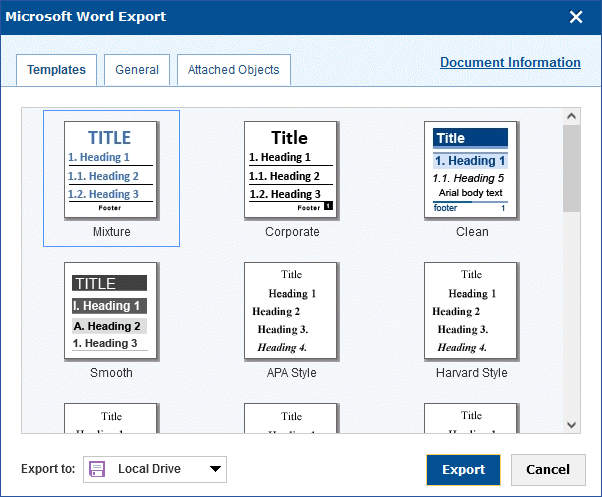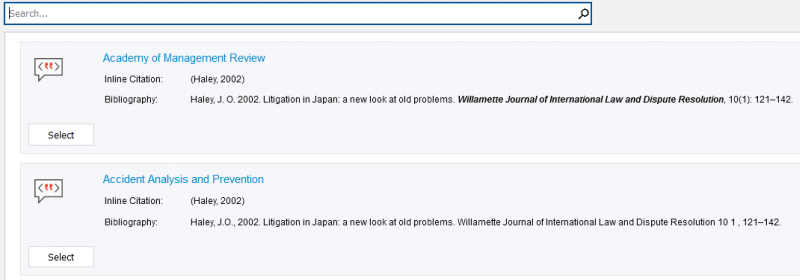 Choose Export
| Word
Choose Export
| Word You can export your mind map as a Microsoft Word document.
 Choose Export
| Word
Choose Export
| Word ![]() in the map workspace or Export | Export
to Microsoft Word
in the map workspace or Export | Export
to Microsoft Word ![]() from the Backstage view.
from the Backstage view.

 Select settings as described
below, or leave the default settings unchanged.
Select settings as described
below, or leave the default settings unchanged.
By default, all text notes, pictures, hyperlinks and branch connections are included, and the exported file includes a title page, a table of contents and a bibliography.
 Select whether you want
to store the exported file on a local drive or on a cloud-based drive
using Google Drive or Microsoft Live.
Select whether you want
to store the exported file on a local drive or on a cloud-based drive
using Google Drive or Microsoft Live.
 Click Export,
and select a location for the exported file. If you chose to store it
online, you may be asked to sign in to the selected storage service.
Click Export,
and select a location for the exported file. If you chose to store it
online, you may be asked to sign in to the selected storage service.
 On the Templates
tab, select the template you would like to use.
On the Templates
tab, select the template you would like to use.
 On the General
tab, select general export settings and specify which elements of your
map you want to export:
On the General
tab, select general export settings and specify which elements of your
map you want to export:
 Select
format settings and options for the table of contents, if you are using
one.
Select
format settings and options for the table of contents, if you are using
one.
![]() If you include a map image and have used the Branch Focus or Detail Level
options to show fewer branches before exporting, the image in the exported
file only shows the currently visible branches. The text of the exported
file, however, includes the text of all branches in the map. For more
information, see "Viewing a mind
map" and "Focusing on
a branch".
If you include a map image and have used the Branch Focus or Detail Level
options to show fewer branches before exporting, the image in the exported
file only shows the currently visible branches. The text of the exported
file, however, includes the text of all branches in the map. For more
information, see "Viewing a mind
map" and "Focusing on
a branch".
 Select
if you want to include a bibliography, and select an export style for
your bibliography and citations. You can either select a Microsoft Word
style or search for an additional style online. If you choose the latter
option, a new browser tab or window opens where you can search for and
select the style you need.
Select
if you want to include a bibliography, and select an export style for
your bibliography and citations. You can either select a Microsoft Word
style or search for an additional style online. If you choose the latter
option, a new browser tab or window opens where you can search for and
select the style you need.

![]() If your document
contains citations, these are always exported.
If your document
contains citations, these are always exported.
 Click
Document Information to enter
information about the document such as title, subject and keywords. Use
commas or semicolons to separate keywords.
Click
Document Information to enter
information about the document such as title, subject and keywords. Use
commas or semicolons to separate keywords.
 On the Attached
Objects tab, select which attached objects should be embedded in
the exported file.
On the Attached
Objects tab, select which attached objects should be embedded in
the exported file.
You can keep custom formatting in your text notes when exporting by deselecting the Clear formatting of text notes check box.
 You
do not need to have Microsoft Word installed on your computer in order
to export to Word. However, on versions of Windows prior to Windows 7,
you need Word 2007 and above to open the exported document. You can also
open the document in an earlier version of Word if you have installed
the Microsoft Office Compatibility pack, available free from the Microsoft
web site. From Windows 7, you can open .docx files directly in the default
editor in Windows without having Word installed, although some of the
more advanced content of the .docx file cannot be shown.
You
do not need to have Microsoft Word installed on your computer in order
to export to Word. However, on versions of Windows prior to Windows 7,
you need Word 2007 and above to open the exported document. You can also
open the document in an earlier version of Word if you have installed
the Microsoft Office Compatibility pack, available free from the Microsoft
web site. From Windows 7, you can open .docx files directly in the default
editor in Windows without having Word installed, although some of the
more advanced content of the .docx file cannot be shown.
 By default, the exported
file will have the same name as the MindView Online document. If you include
a title page, the title of the MindView Online document is also used here.
By default, the exported
file will have the same name as the MindView Online document. If you include
a title page, the title of the MindView Online document is also used here.
 The branches of the map
are exported to Word in the order in which they are displayed, starting
from the top right in a clockwise direction. Each branch is exported as
a paragraph heading at the relevant level; in other words, Heading 1 for
main branches, Heading 2 for sub-branches, Heading 3 for sub-sub-branches
and so on, using hierarchical numbering.
The branches of the map
are exported to Word in the order in which they are displayed, starting
from the top right in a clockwise direction. Each branch is exported as
a paragraph heading at the relevant level; in other words, Heading 1 for
main branches, Heading 2 for sub-branches, Heading 3 for sub-sub-branches
and so on, using hierarchical numbering.
 The export of bibliography
sources and citations is only supported from Microsoft Office 2007. For
more information about sources and citations, see "Using
bibliography sources" and "Using
citations".
The export of bibliography
sources and citations is only supported from Microsoft Office 2007. For
more information about sources and citations, see "Using
bibliography sources" and "Using
citations".
 Text notes are inserted
directly in the Word file.
Text notes are inserted
directly in the Word file.
 The exported Word file
contains hyperlinks to all attached objects in the MindView Online document
that are not selected on the Attached
Objects tab. When the reader clicks a hyperlink to an attached
object, he or she is taken to the MindView Online site where the attached
objects can be downloaded to his/her computer, network or device.
The exported Word file
contains hyperlinks to all attached objects in the MindView Online document
that are not selected on the Attached
Objects tab. When the reader clicks a hyperlink to an attached
object, he or she is taken to the MindView Online site where the attached
objects can be downloaded to his/her computer, network or device.
![]() The reader can only access the online document on MindView Online and
download the attached objects if he or she has a MindView account, and
if the online document has been shared with the reader. For more information,
see "Sharing files and folders".
The reader can only access the online document on MindView Online and
download the attached objects if he or she has a MindView account, and
if the online document has been shared with the reader. For more information,
see "Sharing files and folders".